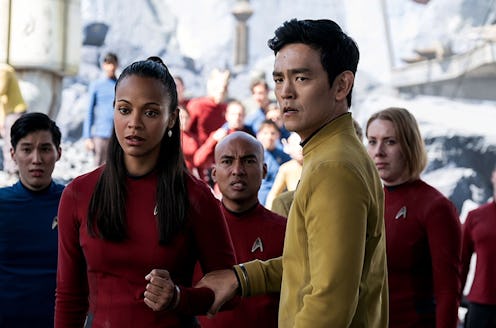
Ever since the Star Trek reboot movie was released in 2009, the new franchise has been called many things, but it rarely, if ever, has been called "feminist." Despite featuring the very strong, smart, and empowered Uhura (Zoe Saldana), that first movie was noticeably lacking in women as extras or speaking characters. For their second outing, filmmakers tried to add a bit more female power to the U.S.S. Enterprise crew by introducing the character of Carol Marcus (Alice Eve). Yet while the effort was nice, Carol was pretty much a dud of a character, so needless to say, the third movie in the series, Star Trek Beyond, had a lot to answer for and a lot to improve upon. Well, I've got some excellent news: Star Trek Beyond is the most feminist Star Trek movie yet, and it's about time.
Beyond, in theaters on July 22, is the first film of the franchise to feature two strong female characters who aren't defined by romantic relationships. First, there's Uhura. Although Uhura has been kicking ass in the past two Star Trek films, which is more than some action franchises can say for themselves, she has, since her introduction, been primarily tied to her romantic appeal. Uhura was introduced in Star Trek as a hot young cadette who caught Kirk's eye at a bar. She was later re-introduced to Kirk in a scene that included a shot of her taking off her sweater and standing in her room in her underwear. And the next time we saw her, it was revealed that she was engaged in a relationship with Spock.
Spoilers ahead! Unlike her previous roles in Star Trek and Star Trek Into Darkness, Uhura isn't defined by her relationship to men in this new film. When Beyond picks up roughly two years after the events of Into Darkness, Uhura and Spock are no longer together, making Uhura an entirely independent character for the first time in the franchise. She also gets a fairly kickass stunt sequence, in which she sacrifices herself for Captain Kirk, and is proven to be an invaluable crew member throughout the film. She's also never a damsel in distress, despite being captured by the villain, Krall. In fact, the film plays on that expectation beautifully in a humorous "rescue" scene involving Spock.
But that's not all. In addition to expanding Uhura's character, Beyond also introduces Jaylah, an independent alien who is extremely proactive throughout the film, and, shockingly, not a love interest for any of the male characters. Played by Sofia Boutella, Jaylah is probably the most badass female character to ever join the franchise, with plenty of stunts, backstory, and emotional weight. She also doesn't have to take her shirt off — a Star Trek movie first. (Fans of Star Trek Into Darkness might remember how Carol stripped down to her underwear in front of Kirk for one of her biggest — and most controversial — scenes.)
Truly, Star Trek Beyond is light years ahead of Into Darkness and Star Trek in terms of female representation. The Starship Enterprise has always been male-dominated, with only one main female character among them, but even off the ship, an overwhelming majority of speaking characters (and, seemingly, extras) were male in the first two films. Figures of authority in Starfleet have also been overwhelmingly male, as have the villains. In Beyond, however, female Starfleet characters previously spotted in the background on the Enterprise play bigger roles in the film. (Although, the fact that I don't remember their names is an indicator that perhaps we could still do better.) And an early scene in the movie introduces Commodore Paris (Shohreh Aghdashloo), a female Starfleet officer, who gives Kirk orders. There are also a few female villain sidekicks, a reminder that women can be powerful no matter what side they're on.
Smaller changes, too, such as the casting of more diverse extras and new costume design, also help make Beyond the most feminist Star Trek film yet. In 2015, an on-set photo revealed that the female Starfleet uniforms had received an upgrade for Beyond. Not only do women like Uhura now get to wear long-sleeved uniforms, but they also are able to display their rank on their uniforms. Male Starfleet uniforms have always had rank established on the wrists of their uniforms, and now that the women have ditched the short sleeves, they get to have the same.
All of these changes, both big and small, help establish a world where there are seemingly just as many women in power as there are men, something we haven't really seen in Star Trek before. Hopefully the movie can act as a model for any future Star Trek movies and Hollywood in general.
Images: Paramount Pictures; Giphy (3)